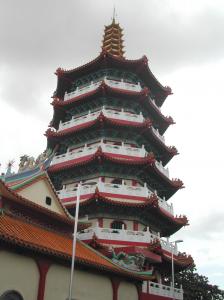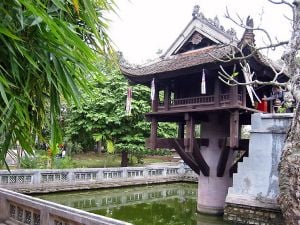Pagoda

- For other uses, see Pagoda (disambiguation).
A pagoda is the general term in the English language for a tiered tower with multiple eaves common in China, Japan, Korea, Nepal, Vietnam, and other parts of Asia. Most pagodas were built to have a religious function, most commonly Buddhist, and were often located in or near temples. This term may refer to other religious structures in some countries. In Thailand, "pagoda" usually means the same as stupa while in Vietnam, "pagoda" is a more generic term referring to a place of worship. The modern pagoda is an evolution of the Ancient Indian stupa, a tomb-like structure where sacred relics could be kept safe and venerated.[1] The architectural structure of the stupa has spread across Asia, taking on many diverse forms as details specific to different regions are incorporated into the overall design.
Terms
The etymological origins of the word pagoda are obscure, but it is a Western term arising during the colonial encounter with the East. The original Chinese is ta which is an abbreviated translation (from tapo) of the Sanskrit stupa. Despite its more recent develpment, the term pagoda is widely used in scholarship, even though some scholars argue that it should be replaced by the more authentic words stupa and ta. Generally speaking, the three terms refer to the same thing.[2]
History of the Pagoda

The pagoda's original purpose was to house relics and sacred writings. [3] This purpose was popularized due to the efforts of Buddhist missionaries, pilgrims, rulers, and ordinary devotees to seek out, distribute, and extol Buddhist relics.[2]
Symbolism
Chinese iconography is noticeable in Chinese pagoda architecture. The image of the Shakyamuni Buddha in the abhaya mudra is also noticeable in some Pagodas. Buddhist iconography can be observed throughout the pagoda symbolism.[4]
In an article on Buddhist elements in Han art, Wu Hung suggests that in these tombs, Buddhist iconography was so well incorporated into native Chinese traditions that a unique system of symbolism had been developed.[5]
Architecture
Pagodas attract lightning strikes because of their height. This tendency may have played a role in their perception as spiritually charged places. Many pagodas have a decorated finial at the top of the structure. The finial is designed in such a way as to have symbolic meaning within Buddhism; for example, it may include designs representing a lotus. The finial also functions as a lightning rod, and thus helps to both attract lightning and protect the pagoda from lightning damage. Early pagodas were constructed out of wood, but steadily progressed to sturdier materials, which helped protect against fires and rot.
Pagodas traditionally have an odd number of floors, a famous exception being the eighteenth century pagoda "folly" designed by Sir William Chambers at Kew Gardens in London.
Some famous pagodas

- Chùa Một Cột- One Pillar Pagoda, Hanoi, Vietnam, is an icon of Vietnamese culture.
- Xumi Pagoda at Zhengding, Hebei, China, built in 636. NO U
- Miruksa Temple Pagoda at Iksan of Chollabuk-do province in the Republic of Korea, a Baekje pagoda mid 7th century.
- Chùa Cầu- Bridge Pagoda, Hoi An, Quang Nam, Vietnam.
- Chùa Ấn Quang, a meeting place for Vietnamese Buddhist leaders in Ho Chi Minh City, and site of the Institute for Dharma Propagation.
- Daqin Pagoda in China, built early Christians.
- Lingxiao Pagoda at Zhengding, Hebei, China, built in 1045.
- Beisi Pagoda at Suzhou, Jiangsu, China, built in 1162.
- Tō-ji, the tallest wooden structure in Japan.
- The Porcelain Tower of Nanjing, a wonder of the medieval world in Nanjing, China.
- Shwedagon Pagoda in Yangon, Myanmar
- Pha That Luang, the holiest wat, pagoda, and stupa in Laos, in Vientiane
- Iron Pagoda of Kaifeng, built in 1049 C.E., during the Chinese Song Dynasty.
- Liuhe Pagoda of Hangzhou, built in 1165 C.E., during the Chinese Song Dynasty.
- Phra Pathom Chedi the highest pagoda or stupa in the world Nakhon Pathom, Thailand.
- Global Pagoda, the largest unsupported domed stone structure in the world.
- Changzhou Tianning Baota, the highest pagoda in the world since its completion in April 2007, stands at 153.7m in height.
- Songyue Pagoda on Mount Song, Henan, China
Modern skyscrapers that evoke pagoda architecture:
- The Petronas Twin Towers in Kuala Lumpur, Malaysia, record setters for height (452m) in 1998.
- Taipei 101 in Taiwan, record setter for height (508m) in 2004 and currently the world's tallest completed building.
See also
- Architecture of the Song Dynasty
- Chinese architecture
Notes
- ↑ The Columbia Encyclopedia, Sixth Edition. Columbia University Press
- ↑ 2.0 2.1 The Impact of Buddhism on Chinese Material Culture By John Kieschnick. Published 2003. Princeton University Press . ISBN 0691096767. pg 31
- ↑ A World History of Architecture By Michael W. Fazio, Marian Moffett, Lawrence Wodehouse. Published 2003. McGraw-Hill Professional. ISBN 0071417516.
- ↑ The Impact of Buddhism on Chinese Material Culture By John Kieschnick. Published 2003. Princeton University Press . ISBN 0691096767. page 83
- ↑ The Impact of Buddhism on Chinese Material Culture By John Kieschnick. Published 2003. Princeton University Press . ISBN 0691096767. page 84
ReferencesISBN links support NWE through referral fees
- The Impact of Buddhism on Chinese Material Culture By John Kieschnick. Published 2003. Princeton University Press . ISBN 0691096767.
- A World History of Architecture By Michael W. Fazio, Marian Moffett, Lawrence Wodehouse. Published 2003. McGraw-Hill Professional. ISBN 0071417516.
- Psycho-cosmic symbolism of the Buddhist stupa, AB Govinda, 1976, Emeryville, California. Dharma Publications.
External links
- http://www.orientalarchitecture.com/kyongju/bulguksaindex.htm
- http://www.orientalarchitecture.com/ Tiger Hill Pagoda (Suzhou)
- http://www.exoticindiaart.com/article/stupa
ur:پگوڈا
Credits
New World Encyclopedia writers and editors rewrote and completed the Wikipedia article in accordance with New World Encyclopedia standards. This article abides by terms of the Creative Commons CC-by-sa 3.0 License (CC-by-sa), which may be used and disseminated with proper attribution. Credit is due under the terms of this license that can reference both the New World Encyclopedia contributors and the selfless volunteer contributors of the Wikimedia Foundation. To cite this article click here for a list of acceptable citing formats.The history of earlier contributions by wikipedians is accessible to researchers here:
The history of this article since it was imported to New World Encyclopedia:
Note: Some restrictions may apply to use of individual images which are separately licensed.

